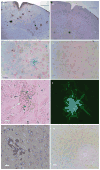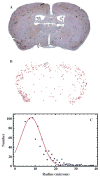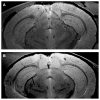SPION-enhanced magnetic resonance imaging of Alzheimer's disease plaques in AβPP/PS-1 transgenic mouse brain
- PMID: 23229079
- PMCID: PMC4801216
- DOI: 10.3233/JAD-121171
SPION-enhanced magnetic resonance imaging of Alzheimer's disease plaques in AβPP/PS-1 transgenic mouse brain
Abstract
In our program to develop non-invasive magnetic resonance imaging (MRI) methods for the diagnosis of Alzheimer's disease (AD), we have synthesized antibody-conjugated, superparamagnetic iron oxide nanoparticles (SPIONs) for use as an in vivo agent for MRI detection of amyloid-β plaques in AD. Here we report studies in AβPP/PS1 transgenic mice, which demonstrate the ability of novel anti-AβPP conjugated SPIONs to penetrate the blood-brain barrier to act as a contrast agent for MR imaging of plaques. The conspicuity of the plaques increased from an average Z-score of 5.1 ± 0.5 to 8.3 ± 0.2 when the plaque contrast to noise ratio was compared in control AD mice with AD mice treated with SPIONs. The number of MRI-visible plaques per brain increased from 347 ± 45 in the control AD mice, to 668 ± 86 in the SPION treated mice. These results indicated that our SPION enhanced amyloid-β detection method delivers an efficacious, non-invasive MRI detection method in transgenic mice.
Figures





Similar articles
-
Optical and SPION-enhanced MR imaging shows that trans-stilbene inhibitors of NF-κB concomitantly lower Alzheimer's disease plaque formation and microglial activation in AβPP/PS-1 transgenic mouse brain.J Alzheimers Dis. 2014;40(1):191-212. doi: 10.3233/JAD-131031. J Alzheimers Dis. 2014. PMID: 24413613 Free PMC article.
-
Clioquinol reduces zinc accumulation in neuritic plaques and inhibits the amyloidogenic pathway in AβPP/PS1 transgenic mouse brain.J Alzheimers Dis. 2012;29(3):549-59. doi: 10.3233/JAD-2011-111874. J Alzheimers Dis. 2012. PMID: 22269164
-
Superparamagnetic nanoparticle-enhanced MRI of Alzheimer's disease plaques and activated microglia in 3X transgenic mouse brains: Contrast optimization.J Magn Reson Imaging. 2017 Aug;46(2):574-588. doi: 10.1002/jmri.25563. Epub 2016 Nov 22. J Magn Reson Imaging. 2017. PMID: 27875002
-
Molecular targeting of Alzheimer's amyloid plaques for contrast-enhanced magnetic resonance imaging.Neurobiol Dis. 2002 Nov;11(2):315-29. doi: 10.1006/nbdi.2002.0550. Neurobiol Dis. 2002. PMID: 12505424
-
Alzheimer's disease: pathophysiology and applications of magnetic nanoparticles as MRI theranostic agents.ACS Chem Neurosci. 2013 Nov 20;4(11):1417-29. doi: 10.1021/cn4001582. Epub 2013 Sep 26. ACS Chem Neurosci. 2013. PMID: 24024702 Free PMC article. Review.
Cited by
-
Nanocarriers as a powerful vehicle to overcome blood-brain barrier in treating neurodegenerative diseases: Focus on recent advances.Asian J Pharm Sci. 2019 Sep;14(5):480-496. doi: 10.1016/j.ajps.2018.09.005. Epub 2018 Oct 22. Asian J Pharm Sci. 2019. PMID: 32104476 Free PMC article. Review.
-
Deciphering the Biochemical Pathway and Pharmacokinetic Study of Amyloid βeta-42 with Superparamagnetic Iron Oxide Nanoparticles (SPIONs) Using Systems Biology Approach.Mol Neurobiol. 2018 Apr;55(4):3224-3236. doi: 10.1007/s12035-017-0546-y. Epub 2017 May 6. Mol Neurobiol. 2018. PMID: 28478508
-
Nanoparticles with Ampholytic Surfaces for Binding and Disintegration of Amyloid Fibrils.ACS Cent Sci. 2025 Jul 2;11(7):1218-1229. doi: 10.1021/acscentsci.5c00519. eCollection 2025 Jul 23. ACS Cent Sci. 2025. PMID: 40726798 Free PMC article.
-
Superparamagnetic Iron Oxide Nanoparticles for Immunotherapy of Cancers through Macrophages and Magnetic Hyperthermia.Pharmaceutics. 2022 Nov 5;14(11):2388. doi: 10.3390/pharmaceutics14112388. Pharmaceutics. 2022. PMID: 36365207 Free PMC article. Review.
-
Quantitative multimodal multiparametric imaging in Alzheimer's disease.Brain Inform. 2016 Mar;3(1):29-37. doi: 10.1007/s40708-015-0028-9. Epub 2016 Jan 8. Brain Inform. 2016. PMID: 27747597 Free PMC article.
References
-
- Hebert LE, Scherr PA, Bienias JL, Bennett DA, Evans DA. Alzheimer’s disease in the U.S. population: Prevalence estimates using the 2000 census. Arch Neurol. 2003;60:1119–1122. - PubMed
-
- Fodero-Tavoletti AT, Villemagne VL, Rowe CC, Masters CL, Barnham KJ, Cappai R. Amyloid-β: The seeds of darkness. Int J Biochem Cell Biol. 2011;43:1247–1251. - PubMed
-
- Masters CL, Cappai R, Barnham KJ, Villemagne VL. Molecular mechanisms for Alzheimer’s disease: Implications for neuroimaging and therapeutics. J Neurochem. 2006;106:1700–1725. - PubMed
-
- Karran E, Mercken M, De Strooper B. The amyloid cascade hypothesis for Alzheimer’s disease: An appraisal for the development of therapeutics. Nat Med. 2011;10:698–712. - PubMed
Publication types
MeSH terms
Substances
Grants and funding
LinkOut - more resources
Full Text Sources
Other Literature Sources
Medical
Molecular Biology Databases

